-

john lawrence sullivan : in the ring
-Tokyoite Arashi Yanagawa, the man behind menswear label John Lawrence Sullivan, has quickly become a fixture of the men’s fashion circuit.
The choice of name for the label is perhaps the most telling. John Lawrence Sullivan, the man, is a heavyweight boxing champion, also known as the “Boston strong boy,” and godfather of sorts to Arashi, who quit a promising boxing career to fight in another type of ring.
Ever since entering the seasonal arena of fashion week in Paris, he’s championed his collections in the eye of attention, with the likes of Suzy Menkes a constant follower. In this context, Arashi’s unconventional vision of the sharp tailored sportsman is most compelling.
 Arashi Yanagawa backstage after his John Lawrence Sullivan presentation. Photography by René Habermacher
Arashi Yanagawa backstage after his John Lawrence Sullivan presentation. Photography by René HabermacherRené Habermacher: Hello Arashi, how is it being back in Tokyo after your last show in the ring fight of Paris fashion week?
Arashi Yanagawa: I’m getting ready for the next match in June. While I’m always relaxed in the end, I also always begin thinking about the next collection right away. It’s exactly the same as in boxing.RH: In your work, specially your most recent collection, I sense a strong fascination with British culture.
but you’re successfully showing your 3rd collection, you chose Paris to present it…
AY: I believe Paris is the most important location for fashion in terms of the both the culture and the history of the industry. Paris has a special eye for beauty and elegance. No other place draws as many journalists, buyers, and fashionistas. All of this naturally makes Paris a very attractive city for presenters, but I also appreciate how strict everyone in Paris is towards creativity.RH: And what is it with you and London?
AY: London has street fashion just like Tokyo, but it also brings history and tradition into the mix. I’m impressed by the way all of this culture has just naturally rubbed off on the younger generations. Another example of something that has really moved me is the culture of the London market where you see young people today buying and even demanding clothing designed a century ago.
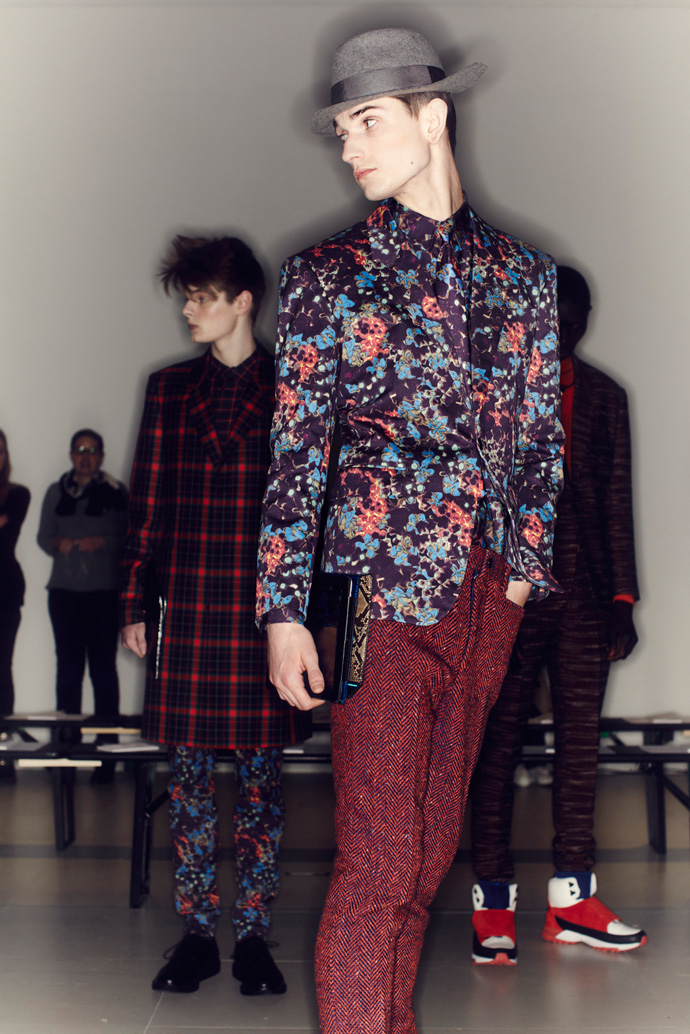 Rehearsals for John Lawrence Sullivan FW13. Photography by René Habermacher
Rehearsals for John Lawrence Sullivan FW13. Photography by René HabermacherRH: how do you decide for what you’ll go next? what is your creative process?
AY: I input the “sense” of the things I see or hear in my daily life and stockpile them. These could be colors, silhouettes, light, or even materials. But, I make an effort to express my own sense of the now rather than just making things based on historical research.RH: For the current summer collection the theme was influenced by the Bauhaus movement.
Why did you feel the urge for this now, and how did you translate that into the clothes?
AY: I had a chance to go to Berlin, so I paid a visit to the Bauhaus school in Dessau and took in the artwork there. I found the combinations of wood, leather, and metal used in the products there particularly interesting, and thought it might be fun to try doing the same things with apparel. So, I made the theme “Bauhaus” and began putting together the collection while referencing architectural cutting, artistic colors, and product techniques.
 John Lawrence Sullivan's "Bauhaus" inspired collection, SS13. Photography by René Habermacher
John Lawrence Sullivan's "Bauhaus" inspired collection, SS13. Photography by René HabermacherRH: can you tell me more about “ELECTRIC AFRICA”: theme of the collection FW13/14, you just showed in Paris, what ideas are behind it?
AY: “Electric Africa” is a coined phrase. I had the idea to create a new, modern vision by combining tribal patterns associated directly with Africa with flashy colors instead of the standard earth tones. Tribal (triangular) elements were worked into various items and aspects like the cutting of the tailored jackets or the placement of the buttons. I also added a spacey essence reminiscent of the crop circles that suddenly appear in fields to the accessories, colors, and textures.RH: This collection also sports extraordinary footwear. Your sneakers have been hailed throughout. How did this design come together?
AY: I wanted create something akin to sneakers or trekking shoes, so I used Vibram soles. I also combined the base colors of the seasonwith highly contrasting hues in order to bring out a sense of Africa. I worked with a brand called ORPHIC when making the shoes.RH: Since you dropped your boxing for founding your label, fashion in Japan underwent quite some changes. How do you see the japanese approach today, what is your viewpoint and what influenced you over the course of time?
AY: When I started my brand in Tokyo my image was much more aggressive. I feel like back then many of the magazines adopted a fashionable approach, and that the buyers tried to answer the challenges the designers undertook with respect. But, as the economy got worse the magazines switched to much more easy to understand catalog-like appearance in order to make sales, which in turn influenced buyers, whose customers were influenced by this, to become much more conservative in their selections. So, there were a lot of negative things occurring in fashion here. The Tokyo runway shows were no different, as the focus shifted conspicuously to more “real” presentations rather shows with a bit a fantasy or elegance to them. Feeling all of this made me want to do my shows somewhere more stimulating, so I chose Paris.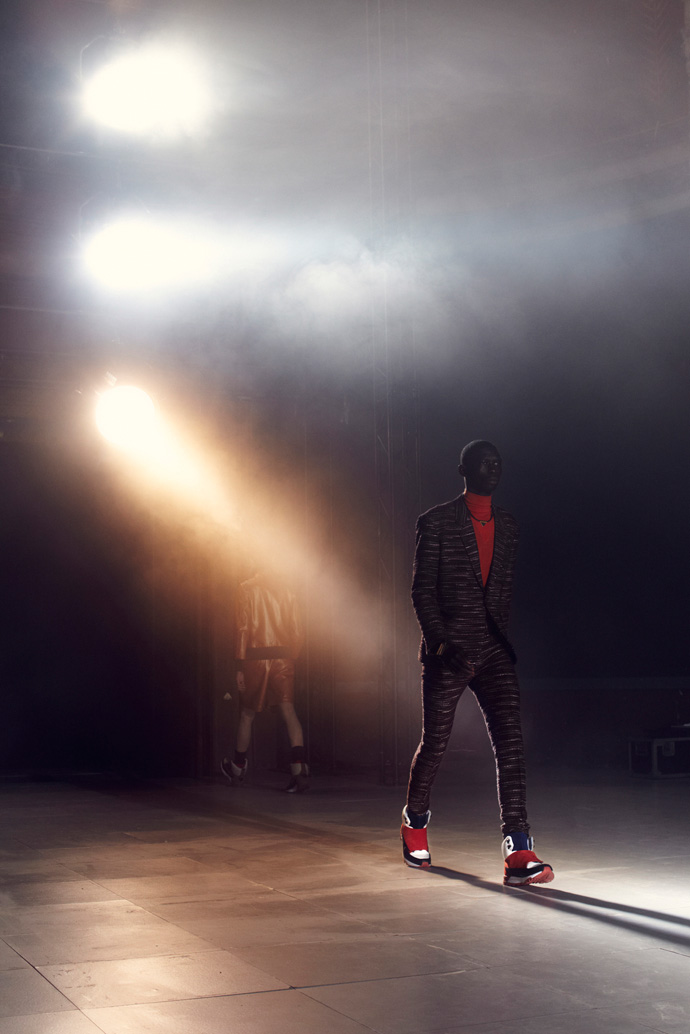
 "Electric Africa", John Lawrence Sullivan FW13. Photography by René Habermacher
"Electric Africa", John Lawrence Sullivan FW13. Photography by René HabermacherRH: While developing your collection, are you having a specific type of man in the back of your head?
AY: I always imagine a man who possesses both beauty and strength in terms of appearance and mind. If I were to provide a sportsman as an example, there is a certain boxer who comes to mind…RH: Are there any parallels you can draw between your sports career and the one in fashion?
AY: One thing I realized when I first started working in fashion is that there is a common trait shared by boxing matches and fashion shows that only I seemed to notice. This was the way in which you worry over something that will last only few minutes on a single day for months in advance, battling with your anxieties and, as long as you don’t give up, preparing for the next match as soon as it’s all over regardless of whether you won or lost. The way everything seems so fleeting and transient once it’s all said and done is also the same.RH: The understanding of classic tailoring is a very strong element in your work. Now you started your women’s line: how does this apply here?
AY: Incorporating classic tailoring into women’s fashion is one of the most important elements for John Lawrence Sullivan. This isn’t something just any brand can do, so it’s something we will continue to actively working with in the future. One of the differences between men’s and women’s fashion for me was the way in which things like esthetic elements concealing points I had complexes about confused me a bit at first. Now I feel that I have learned to use men’s techniques to deal with these things. Showboard with looks and cast for "Electric Africa". Photography by René Habermacher
Showboard with looks and cast for "Electric Africa". Photography by René HabermacherRH: As you added another collection to your house – your work wheel must spin faster evidently, with 4 instead of 2 presentations.
AY: I always think of how I can break down the restrictions of the tailored look when I do my men’s designs. While there is the sense that I can be confident in breaking these restrictions down precisely because they exist, but with women’s my process is one of imposing my own restrictions on the things I design freely. So, there is a sense of mutual stimulation between my men’s and women’s lines that has been a good influence in my opinion. That said, I am definitely much busier than before…RH: Do you feel urged by the increasing numbers of pre-collections and cruise collections that the big houses lately launch?
AY: This is most likely just a sign of the conservative sales trends we’re seeing worldwide right now.The big houses are just doing this as a way of making sure they continue to pull in revenue. I too feel that JLS must do the same if we are to continue showing in Paris, so I’ll be considering various strategies for this in the days to come.RH: With clients all over the globe in different climate zones: do “season oriented” collections make still sense to you? (already the weather in Japan is quite different to the north american or european)
AY: Breaking things up by season allows designers to change up their mood and add depth to the presentation, so I most definitely think it has meaning. But, I also feel that in terms of actual sales it is often seasonless items that perform the best. "Electric Africa", John Lawrence Sullivan FW13. Photography by René Habermacher
"Electric Africa", John Lawrence Sullivan FW13. Photography by René HabermacherRH: How do you perceive the present of fashion?
AY: I think what we are seeing is a mixture of various styles coming together.
This is also exactly why I feel that you can’t make it in this day and age unless you believe in yourself and keep making bold presentations. I guess you could say I feel we’re in an era where only the essentials survive. I want JLS to continue to be a brand that always takes up the challenge of presenting in Paris.RH: What is up next?
AY: The designs for my women’s exhibition in March and preparations for the 2014 S/S season.RH: What is the last thing you saw, read, heard or felt that stimulated you?
AY: Tadao Ando, James Turrell, Donald Judd, Taro Okamoto, Talking Heads, Pixies, David Bowie, Wes Anderson, Jim Jarmusch, Kinji FukasakuWebsite: John Lawrence Sullivan
00 -

editor MASANOBU SUGATSUKE : An edit of an edit
-Masanobu Sugatsuke is one of the most influential editors, publisher of magazines such as COMPOSITE, INVITATION or METRO MIN in his native Japan, and of books with Mark Borthwick, Elizabeth Peyton or Jeff Burton. Masa considers himself not exactly a trendy person, yet is always on a forward trail, much ahead of his time.
THE STIMULEYE talked with Masa on the outlook of publishing and the editors future role, but also his recent book EDITORIAL PARADISE in which he is looking on his past editorial work. A reflection in a radical manner, rarely dared by others of his guild.
An edit of an edit, a compilation of compilations?
He’d been advised by a fellow columnist that “When an editor enters the spotlight, he automatically announces that it is time for him to go” he was told, as well as “an expression reaches a deadlock the moment it becomes self-referential”.“But wait a minute,” he writes in his foreword, “Godard and Truffaut initiated the Nouvelle Vague with their filmic reflections on film; contemporary art has developed as a form of “Art reviewing art”, and Rei Kawakubo and Martin Margiela keep proposing dresses that inspire the wearers to think about dressing. Could it be that there exists a whole different level that self-expression can only reach after going through the painful stage of self-reference?”
 Works of Masanobu Sugatsuke laid out for EDITORIAL PARADISE.
Works of Masanobu Sugatsuke laid out for EDITORIAL PARADISE.When i visited you at you last time in Tokyo at your office – we had not seen each other for quite a long time.
Meanwhile you had halted “Composite” , and published your book “Editorial Paradise” revisiting your inventive editorial work of the last 25 years. Interestingly, this reflection coincided with a turning point, a time where the role of the editor is challenged through mechanics introduced by new media. To me it almost felt like a “katharsis” (精製) – in this context. Not only a personal one…
Talking about my book “Editorial Paradise”, I think that a retrospective book of a living editor sounds strange for everybody, even for me!
But to edit and launch it, it made me consider a lot about the role of editors and definition of editing nowadays.
I believe the role and definition of editors and editing has been drastically changing these days, because of the growing role of new media. But a few editors have been trying to define their new roles and public meaning.“katharsis” you mentioned is quite a suitable word to describe my time editing this title. Editing this retrospective is like confession for me. But confessing what?
I can tell you about it clearly now, I didn’t know the meaning of editing until that time.For this book you told me you’ve decided to include everything from the volumes that you’ve done, which is somehow “anti-editing” – was that part of making you realise the meaning of editing? What is your conclusion?
I’ve always aimed to expand the definition of editing. Through the editing process of this editorial retrospective, I recognized that the changing state of editing my thinking simple-minded.
So, what I came across through this process, – it was fun but hard for me to think deeply about editing all the time all day long and I felt like being ouroboros – is that editing is not about media.
I think editing is a way of thinking. It’s not like making film, designing a website. It’s a purely abstract idea to make something concrete.My definition of editing is quite simple.
1: Drawing up a project,
2: Recruiting a team of collaborators,
3: Creating something,They are the three basic conditions of editing, I think. If someone does something with these three conditions, whatever it is, I’d like to say “that’s editing”.

 Sleeve of EDITORIAL PARADISE with an illustration of Masanobu Sugatsuke by Florence Deygas and a recent LIBERTINES cover
Sleeve of EDITORIAL PARADISE with an illustration of Masanobu Sugatsuke by Florence Deygas and a recent LIBERTINES coverIt’s something rare in this profession to put a focus on the act of editing itself, especially one’s own and in such a radical way as with your latest book.
As you can see, editors have been defined as interpreting someone to someone else, or something to something else. That means “Don’t express your own voice through your works. You are an in-between guy!”.
That’s 50% right. But there are so many high-profile advertising creative people all over the world. They are not behind the media at all nowadays.I believe editors are mainly present in-between and behind media, but sometimes they are beyond media, i.e, Anna Wintour, who is Cabinet Minister of the Ministry of Cool, Terry Jones, Everlasting Evangelist of Street Style and Olivier Zahm, the second Gainsbourg.
I believe we, creative people, have to label ourselves. In other words, we have to “transform life into creation”.
Because, in this 21st Century, our creative lives are almost viewed and leaked by web and twitter.
It’s been getting hard for creative people to avoid being watched or criticized by ordinary people now.Iconic editors from the past seem in this context like vanguards of another time to come:
Diane Vreeland (American Vogue) or, on another side of the spectrum, Hugh Heffner (Playboy), both transcended their editorial vision with their personal lives.Today’s ever more fragmented stream of information requests perhaps a stronger necessity of structure through the personal standpoint…
How do you think the element of today’s over-exposure is influencing the role of the editor?
Over-exposure is big phenomena in our world, not just for editors. Modern people are fame-addicted.
On the other hand, we can show our way of living as an art piece. Lady Gaga’s case is the most excessive one, and Haruki Murakami’s case is the most stoic.
But both are most successful presentations of life as art piece today.As I said, our creative lives are mostly viewed, watched by the media and each action are “timeline”d.
So if you can’t avoid it, you have to be determined to show your life as whole art piece, as if Andy Warhol presented us.
So, Warhol said “Everyone will be famous for 15 minutes” in the 60’s.
But now everybody became Andy Warhol, just like taking photo everyday, quoting somebody’s ideas and images and commenting as one phrase philosopher on twitter or blogs.Our creative works are slices of our creative lives. People nowadays have a tendency to prefer the real lives of creative people to their work.
 Spread of "AISIAN FASHION NOW" from a recent issue of LIBERTINES. Photo by Leslie Kee
Spread of "AISIAN FASHION NOW" from a recent issue of LIBERTINES. Photo by Leslie KeeIn these times, the stream of facebook statuses, tweets and re-tweets, tumblr and so on form a new way of consuming information.
You recently mentioned Paper.li to me – which seems like an attempt to “master” this stream almost a form of an “automatic generating editor”….Yes, “Paper.li” is a kind of semi-auto-updated personal web magazine. On the web, if you curate something, you can be an cool editor. Therefore “first hand” is getting more important for media and creative people. Audiences can’t get interviews of celebrities and take their photo first hand.
So, “first hand” sources and high profile people are the last sanctuary of professional media and creative people.
But if they are lazy to maintain “first hand” capability, audiences will rob it.The internet is certainly a big accelerator of this “theft”!
What we’re missing out besides “first hand” is the synthesis of information and its digestive analysis.
I am wondering how do you expect the print media to react to this and how you see its perspectives in the long run, in balance with the digital publishing?I expect that print media will live with digital media in symbiosis. I believe print media will survive, as opera and theatre play do.
But not mainstream in the media.
There are two kind of information, flow and stock.
Internet is a best media of flow information. Print media is a best of stock information.
For creative people, beautiful books must be great tangible assets.
In this 21st Century, tangibility and physical experience can be more important because internet cannot provide them. Opener of the Yohji Yamamoto Interview of LIBERTINES
Opener of the Yohji Yamamoto Interview of LIBERTINESYou have recently halted publishing your most recent print magazine “libertines”-
what was your experience with this? Were the reasons related to the shift in publishing that we’re talking about?Talking about the end of “Libertines” magazine, I think I was a little bit too optimistic about the advertising climate and today’s readers. It was my fault.
Advertising for magazine has been drastically decreasing. I knew it. But I had estimated that I could have get a certain amount of it when I started “Libertines”.
But I couldn’t. It was worst time to start a new magazine in Tokyo with a professional level of budget.Plus, I thought we could get a number of readers similar to what we had before. So, for the first issue of “Libertines”, we had a special feature about twitter culture.
We had exclusive report about twitter headquarters in San Francisco in it.
As you can imagine, we got big buzz on twitter and web when it came out.
BUT this buzz were not enough to sell magazine.It is a similar situation for musicians and the web. If some musicians get big buzz on twitter and facebook, but their record sales are not related with buzz unfortunately these days.
It happens in magazine world.I think “buying magazines” has become an old habit, or habit for people over 30’s.
If you aim to produce youth culture-medias and package contents, there are few actual youth consumers who buy them naturally.On the other hand, I’ve been directing another magazine “Metro Min.” for two years as creative director, it is quite successful because it’s a monthly free lifestyle magazine which is published by a major publisher.
So, it is hard to sell magazine to the FREE generation. I’ve been struggling with this issue.
I don’t have a clear solution for it. But I’m not pessimistic about the future of magazines. I think publishers and editors have to organize a new kind of structure to make profit not only to produce print medias.I believe there are great examples in the movie industry. The movie industry is not just about movie theatre nowadays as you know. It is an environment with movies.
I think that’s the hint for editors.

 Covers of METRO MIN, the most recent publication of Masanobu Sugatsuke
Covers of METRO MIN, the most recent publication of Masanobu SugatsukeWhere do you see the future?
I’ve been thinking about the fate of both print media and new media all the time as I mentioned in our previous conversations.
And as you see, nobody knows. But there is one certain thing that I can say, that is if you love something, you’d like to own and touch it.
Same as your lover. That’s the human nature which will not change forever.People nowadays talk mainly figures and speed of modern media. But media are not only produced by them. Of course, these specs are important.
But images, sympathies, affections and favoritism are very important elements of media.
If these elements are all included in one media, then it will be a loved media no matter if it’s in the form of digital or print.I believe that creative people have to concentrate on how to produce a loved media to audiences. I think that’s the priority.
The last thing stimulated that stimulated you?
So many things and it is hard to answer to choose one particular thing.
Here is the list what I was stimulated after 3.11, the Great Earthquake in Japan.# Cindy Lauper concert in Tokyo on March 17th, just 6 days after Earthquake.
Cindy is a quite brave artist who did Japan tour in such a catastrophic situation and she commented during each break between songs to encourage audience in Japan.
She sang her masterpiece “True Colors” in encore with mix of John Lennon’s “Power to the people” and almost the whole audience, including me, wept.# Takashi Homma photo exhibition at Tokyo Opera City Gallery in April
Homma’s biggest exhibition in Tokyo which shows his conceptual landscape in Japan and Los Angels which was collaborated with Mike Mills.# Jane Birkin Charity live at Shibuya Club Quattro, April 6th
Jane Birkin is not just an actress or singer. She is a role model of modern women.# Anti-Nuclear Demonstration in Koenji, Tokyo, April 10th
Most biggest and joyful anti-nuke action in Japanese history. So many musicians joined it and I participated in it. People have the power!# Saburo Teshigawara dance performance at Kawasaki City art center, May 6th
It is a final answer to the question “How can movement of human body be radical and beautiful”. Teshigawara does European Tour this Autumn. Must-See!# Henry Darger exhibition at Laforet Museum Harajuku, Tokyo, May
Legendary outsider artist’s big retrospective. So innocent and scary.# Yohji Yamamoto’s 30th anniversary party of his brand at Y.Y boutique in Tokyo, June 1st
Yamamoto is a last samurai of cutting edgy couturier. Congratulation!
-

SAVE TOKYO CREATION
-This week, under the helm of curator Takafumi Kawasaki, 18 hot Japanese fashion brands and 10 photographers team up in Tokyo for SAVE TOKYO CREATION. As the official Tokyo fashion week was cancelled due to the recent events, stylist Takafumi Kawasaki initiated this show to give young designers an opportunity showing their collections from May 27th to 29th at EYE OF GYRE, Omotesando, Tokyo. Accompanying the show, artworks by Tokyo Posse ENLIGHTMENT will be on display, and a fanzine produced.

 Poster of SAVE TOKYO CREATION by ENLIGHTMENT. Photography by Yasuyuki Takaki
Poster of SAVE TOKYO CREATION by ENLIGHTMENT. Photography by Yasuyuki TakakiThe 18 designers produced special pieces for the project to be auctioned for donation. Among the designers showing, is much beloved Jun Takahashi for UNDERCOVER, YOSHIKO CREATION, famous for her unique pieces to Lady Gaga, TOGA, N.HOOLYWOOD and emerging designer JOHN LAWRENCE SULLIVAN, among others as ANREALAGE, G.V.G.V., KEITA MARUYAMA TOKYO PARIS, MAME, MINTDESIGNS, SACAI, SOMARTA, KOLOR, PHENOMENON, TAKAHIROMIYASHITATHESOLOIST, ISVIM, WHITE MOUNTAINEERING and YOSHIO KUBO.
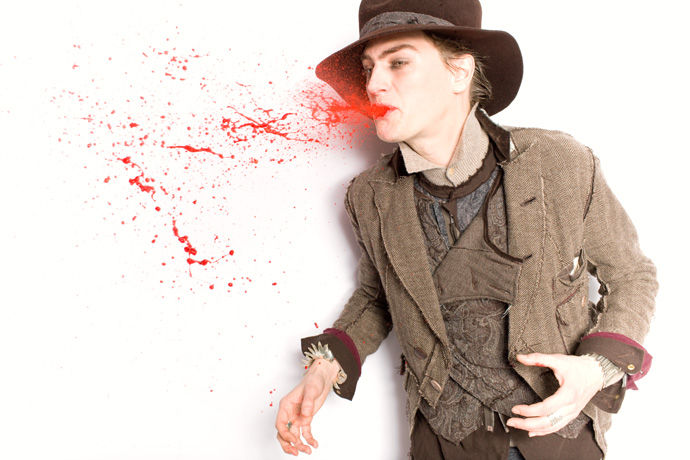 SAVE TOKYO CREATION Photography by Keiichi Nitta
SAVE TOKYO CREATION Photography by Keiichi NittaThe designers AW 2010 designs were picked up by Photographers and lensed especially for that show: Akira Kitajima, Chikashi Kasai, Tajima Kazunali, Keiichi Nitta, Leslie Kee & Ryan Chan, Masahiro Shoda, By P.M. Ken, Yasumasa Yonehara and Yasuyuki Takaki.
The Stimuleye spoke with Takafumi Kawasaki
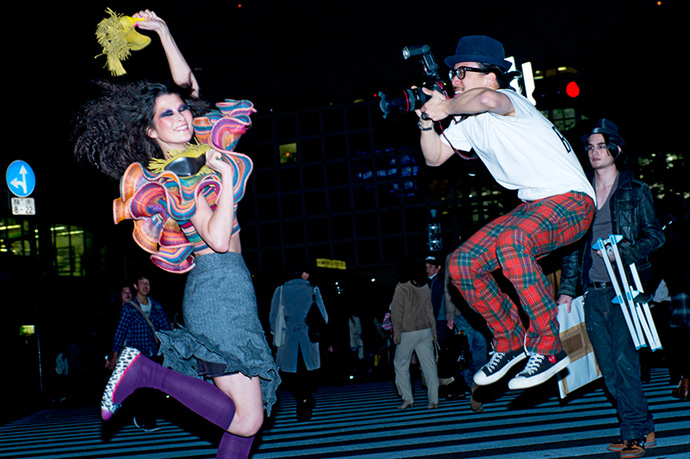 SAVE TOKYO CREATION Photography by Leslie Kee & Ryan Chan
SAVE TOKYO CREATION Photography by Leslie Kee & Ryan ChanRENÉ HABERMACHER: What was your intention with this exhibit?
TAKAFUMI KAWASAKI: SAVE TOKYO CREATION supported by NARS is a big feature of Japanese fashion designers, most of whom lost a chance to exhibit their 2011AW collection because of the earthquake impact.
It’s a charity but not a money-donated oriented.
I wanted to provide Japanese fashion designers a chance to show their 2011AW collection that could not be shown on catwalk because of the earthquake.
As a fashion director & stylist, I believe it is a form of charity that only I can produce to provide those designers with the opportunity to present their creation in public.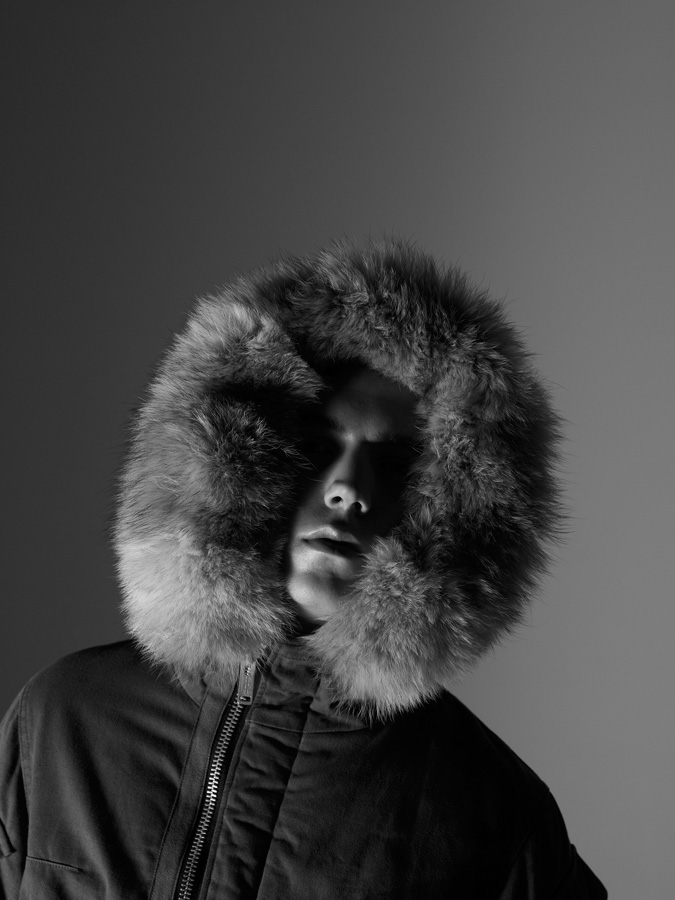
 SAVE TOKYO CREATION Left: Photography by Kazunali Tajima. Right: Akira Kitajimat
SAVE TOKYO CREATION Left: Photography by Kazunali Tajima. Right: Akira KitajimatHow did the earthquake and its aftermath affect you personally?
The earthquake made me find the huge scepticism about Japanese government and the power of citizens. I would say I feel my approach to fashion and my styling works became more clearer and straight forward.
It may sound a little funny but I became more optimistic about the life. What already happened, happened, even if it’s a massive tragedy, there is no way to change or dismiss it. I feel there is no point to keep crying over that. But what we should do now, is to step forward.
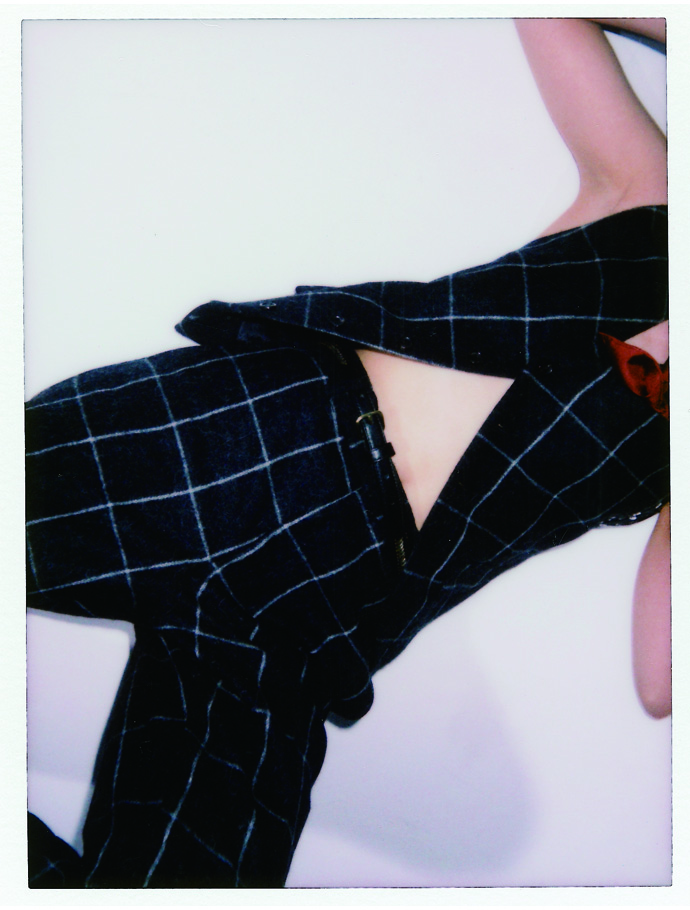
 SAVE TOKYO CREATION Photography by Yasumasa Yonehara
SAVE TOKYO CREATION Photography by Yasumasa YoneharaDo you feel there is a different mood now among japanese society? I am asking as Japanese people expressing in the past to feeling alienated to their fellow countrymen…
Yes, “alienation” is a serious issue after the quake. Japanese people appear to be longing for the tightly-bound feeling.
Not only real communication and society, but also they are keen to make bonds with others in virtual community, such as Facebook, Twitter and other numerous social media networks. Some people are obsessed about that too much.Generally speaking, however, I think the Japanese people have found what is important and what is less in life. I believe this is a great chance to reform the typical Japanese convenience-oriented life.They appear to have started making their lives a little slower and calmer, too.
It’s really a big shift of the country. SAVE TOKYO CREATION Photography by Chikashi Kasai
SAVE TOKYO CREATION Photography by Chikashi KasaiWhat is the last thing that stimulated you?
I would say THE EARTHQUAKE in Japan.The exhibition is held from May 27th to 29th at EYE OF GYRE, Omotesando, Tokyo.
 SAVE TOKYO CREATION Photography by Masahiro Shoda
SAVE TOKYO CREATION Photography by Masahiro Shoda
